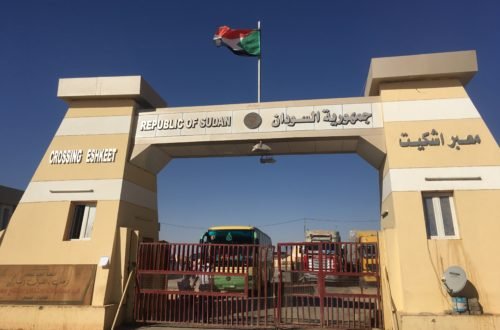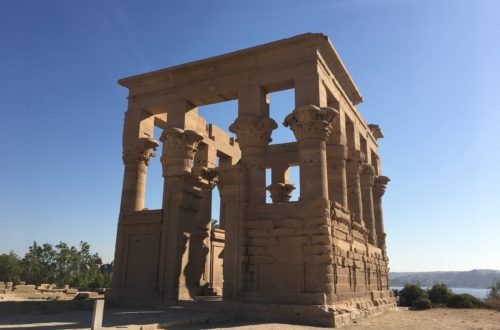
Hatchepsut, the female pharaoh & Queens Valley
Hatchepsut, the female pharaoh… If I say pharaoh, you surely picture a nice good looking topless man, wearing a stylish beard and a white linen loincloth. His eyes are circled with khôl, a gorgeous gold and lapis lazuli pectoral around his neck. On his shaved head, the characteristic red and white Egyptian crown and in his hands the sceptre and a whip.
It is very unlikely you would picture a woman, nor associate a woman with the role of pharaoh. This makes Hatchepsut a very interesting pharaoh. I knew her mortuary temple from pictures on travel websites. But I had no notions of who she was, of how unusual she was for her time.
When we think about “queen of Egypt”, names such as Nefertiti and Cleopatra come to mind almost immediately. The first was the wife of Akhenaton and famous for her legendary beauty. The second was the last queen of Egypt and the Ptolemaic dinasty. Hatchepsut would not necessarily come to mind but is quite a unique case. Archaeologists argued about her sex for decades. The list of Ancient Egypt mysteries grows bigger and bigger.
I find it quite interesting to look at history through the spectrum of women who lived at that time. As a result, I decided to include in my program the visit of Hatchepsut temple and several tombs in Queens Valley. Let us see what legacy these women passed to us.
/ A unique architecture for Hatchepsut
/ Playing music in the bark hall
/ Hatchepsut, the female pharaoh
/ Zenith and decline of Hatchepsut’s reign
/ Inside the tombs of Queens Valley
/ Related: Egypt, Luxor, Theban necropolis, Hatchepsut, Queens Valley
/ Inspiration:
Ramses – The Son of Light (by Christian Jacq, 1995)
The Mummy (film by Stephen Sommers, 1999)
Rome (series by Bruno Heller, 2005-2007)
A unique architecture for Queen Hatchepsut
This is a worldwide famous temple coming to us from Egyptian Antiquity. Queen Hatchepsut (1505-1484 BC) had it made for herself and for her father Thutmose I so that people would come worship their memory and pray to the god Amun. The architect Senenmut created this unique design for her.
There are not enough adjectives to qualify his creation. Impressive, royal, bold, modern, balanced, geometrical, elegant, beautiful, huge, unique… Never seen before! And I should add, never seen after neither! I do not know any other place in the world that look like that.
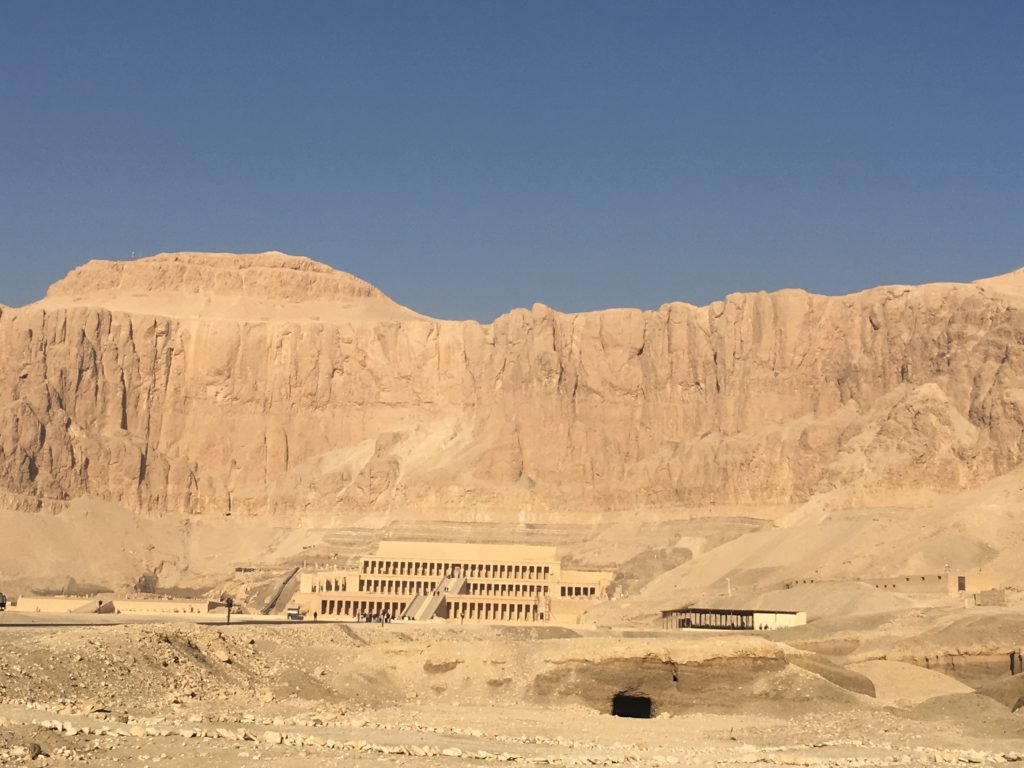
Hatchepsut temple is nestled at the foot of the semi-circular mountains. Looking from afar, I would say you could not pile more than 3 or 4 Hatchepsut’s temples to reach the top of the mountain. And it s quite a tall mountain. From the rooftop terrace on my hotel, I can see the temple illuminated at night. About 4 kilometres separate them. That gives you an idea of the size of it.
The road leading to the main central stairs seems to stretch to infinity. The three terraces have each perfectly aligned pillars. On the third and last level, every pillar bares a monumental Osarian statue of Hatchepsut standing with her arms crossed on her chest, in a position of majesty.
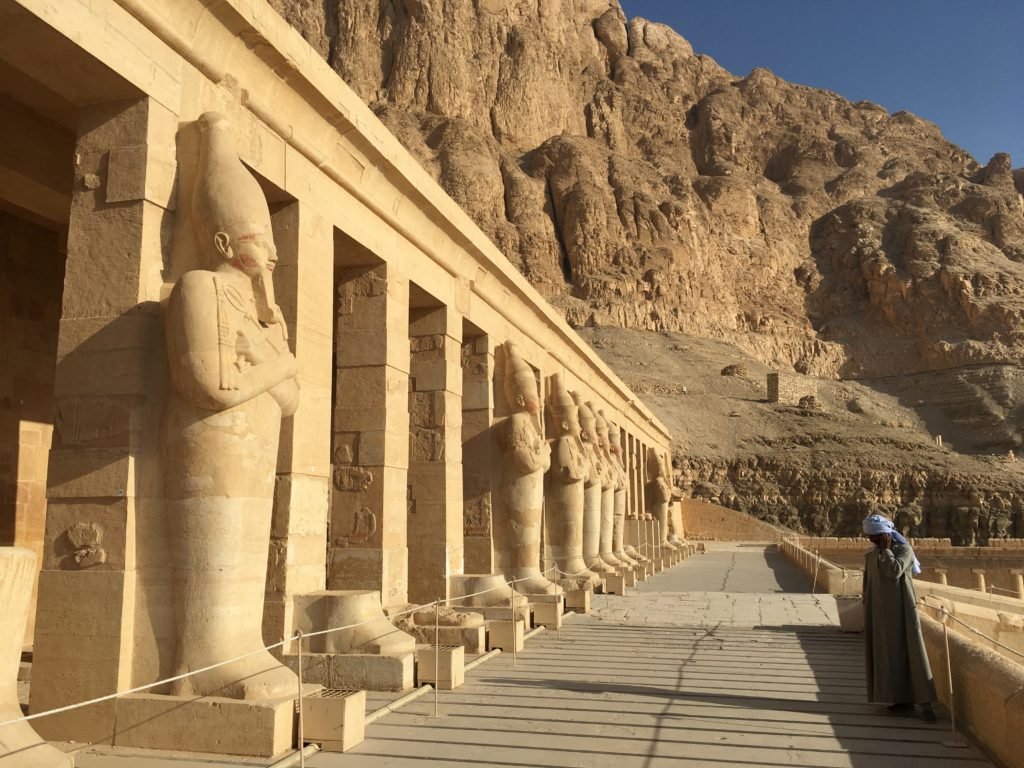
I climb the steps and reach the first esplanade. It is like playing a game in which each world you exit brings you into another one similar and slightly smaller than the previous (Russian matrioshka principle). Only, you actually make progress and get nearer from your final destination.
I turn and embrace the stunning view on the valley. The horizon disappears in the hot mist of the desert. It is still early morning but the sun is already strong and not a cloud in the sky. A few more steps and I reach the third and last level. Behind the pillars, there is a passage which leads inside a courtyard and then to the Amun-Re sanctuary and its bark hall.
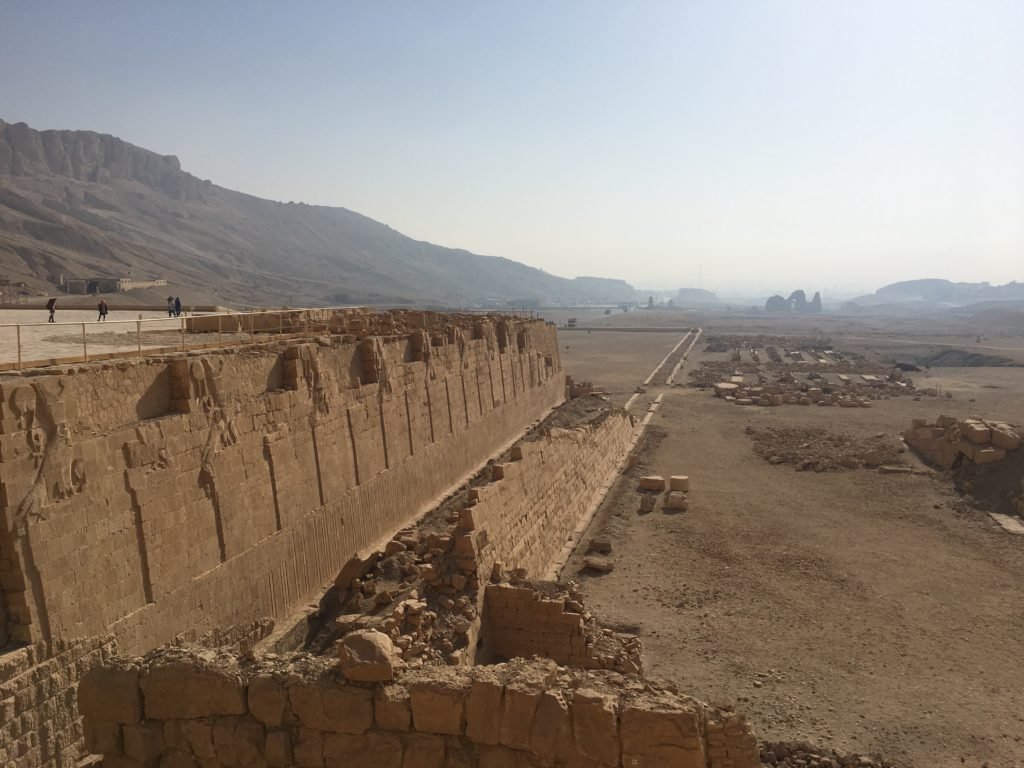
Playing music in the bark hall
The sanctuary does not look impressive at all. Beautiful paintings cover the walls and ceiling but are in a rather poor state of conservation. The dimensions of the sanctuary are incredibly small compared to the temple. The ceiling reaches perhaps 7 metres at the highest point.
I am about to leave when a tourist enters with his wife and guide. He starts playing a melody with a wooden flute. The air fills with the merry notes and the sound echoes on the painted walls. The guide smiles and starts to sing to accompany the flute.
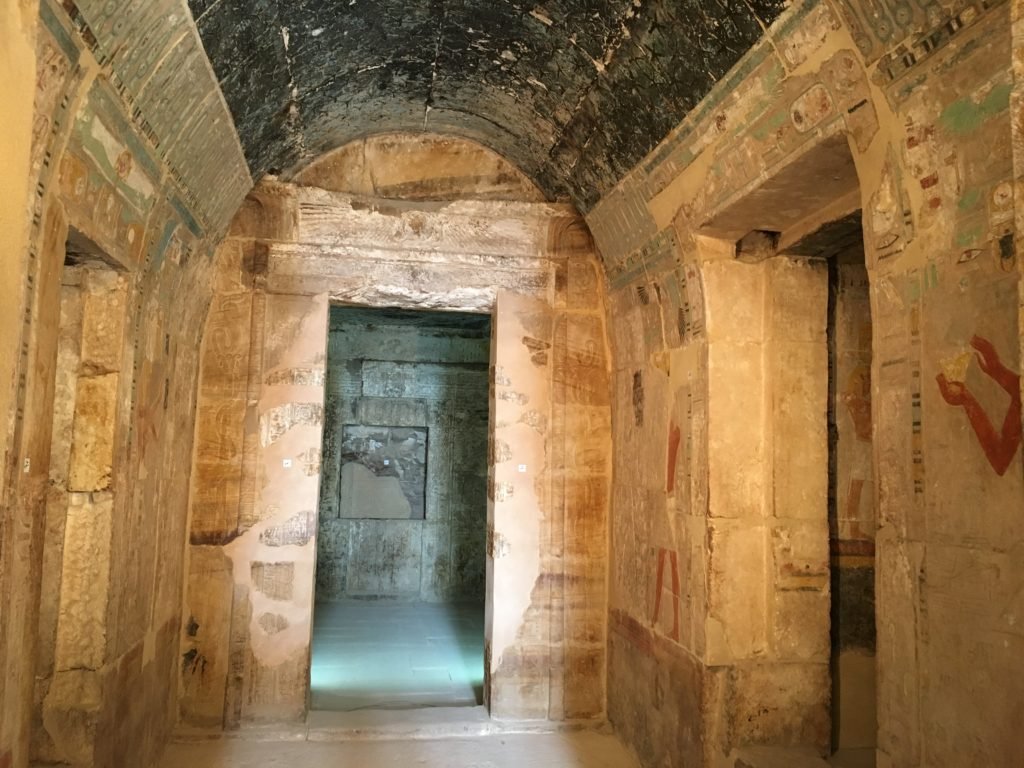
The scene is beautiful and totally unexpected. Am I really standing here on a visit of an Egyptian temple right now? The melody and the song last less than a minute. After which, I dive back into reality. We say hi and everyone resume their visit.
I learn more about the bark hall. During Feast of the Valley (early summer), the bark of god Amun would come from Karnak temple to the sanctuary on the opposite bank. Amun travelled using the Nile and canals, visiting the West bank gods such as Hathor.
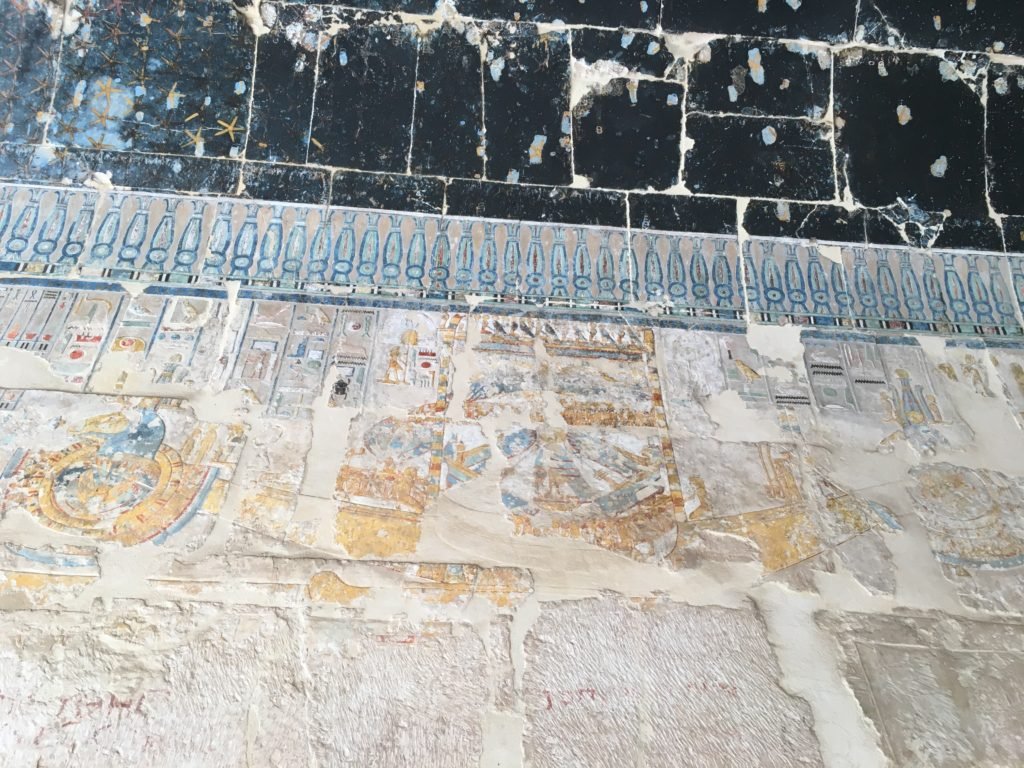
The temple was usually accessible only to the pharaoh and the priests for rituals purpose. Between the 11th and 7th century BC however, the third level serves as a necropolis. The sanctuary then turns back into a place of worship of Amun and its bark. Later, in the 2nd century BC, it changes for the cult of the deified personages Imhotep (Saqarah Djoser pyramid architect) and Amenhotep.
In the 6th century AD, it becomes part of St Phoibammon Coptic monastery. Until it turned into ruins, collapsed and became barely recognizable. A Polish archaeological team performed intensive renovation of the temple to give it back its appearance as it was at the time of Hatchepsut.
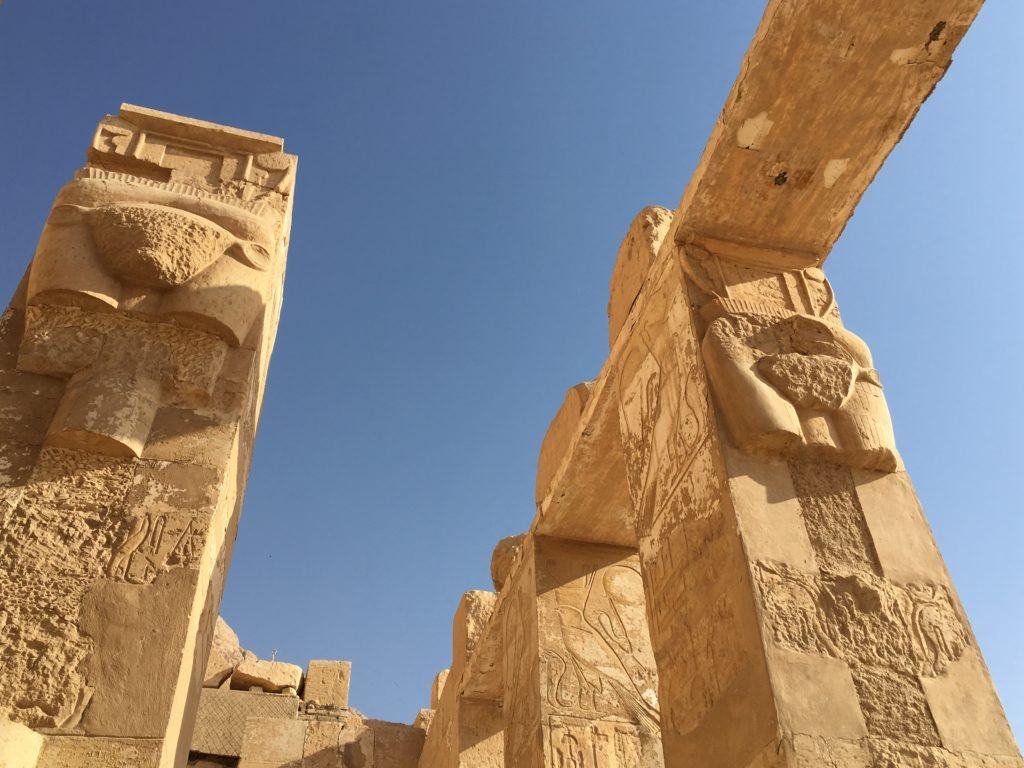
Hatchepsut, the female pharaoh
Queen Hatchepsut (1505-1484 BC) must have been quite a woman. Daughter of Tuhtmose I and wife of Thutmose II who happens to be her half brother. When her husband dies, she denies the throne to his son by his secondary wife Iset, Thutmose III, and takes the crown for herself. Her reign starts in 1505 BC, she is about 30 years old and will rule as pharaoh during two decades.
Hatchepsut makes several adjustments to secure her power. It includes her appearances and her lineage. She dresses like a man and wears a false beard, symbol of the pharaoh. The representations of Hatchepsut show her as a man. Her statues are painted in red when yellow is the colour for females. I look at the monumental pillar statues and the smiling face of Hatchepsut. She looks royal, she looks like a true pharaoh.
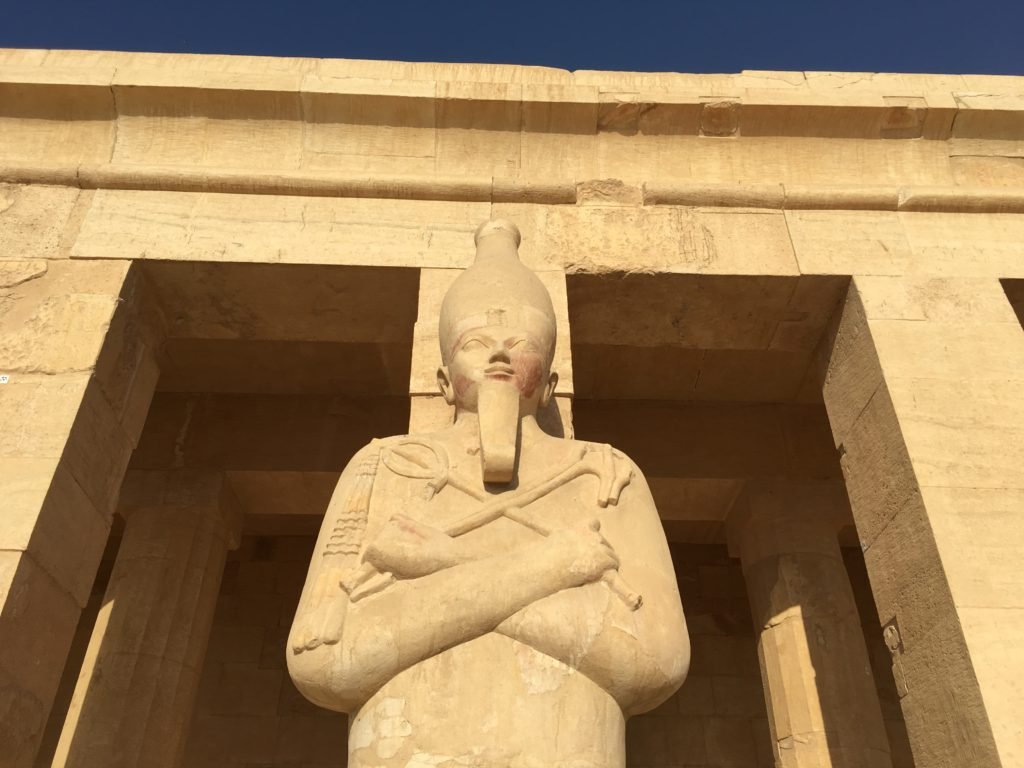
Being the daughter, wife and mother of pharaoh does not make you one. Even if you pretend to be a man, that is not enough. Hatchepsut had to reinvent the story of her birth. By proclaming herself daughter of a god, she wipes out all contests for her position as a pharaoh. Another pharaoh would imitate her a century later: Amenophis III.
The second terrace room right from the stairs depicts the story of Hatchepsut’s divine birth. Painted frescos tells the wedding between the mighty god Amun-Re and Ahmose, Hatchepsut’s mother. Various stages of her pregnancy lead to the birth scene of Hatchepsut. There is even a scene where the god Amun-Re declares that Hatchepsut is his daughter and as such the rightful pharaoh to rule over Egypt. We have to admit, the message could not be clearer!
Zenith and decline of Hatchepsut’s reign
One highlight of Hatchepsut’s life, beside the temple of course, is the expedition in the land of Punt in 1493 BC when she was still a queen. This territory corresponds to modern Somalia in the horn of Africa. The purpose of this expedition was purely exploration.

Some of the discoveries are celebrated in Hatchepsut temple. One of the rooms is entirely decorated with plants and animals from Punt. At the temple’s entrance, a sign reminds the visitor of the expedition. Various trees, flowers and animals were brought back to Egypt from “the land of the gods”.
Hatchepsut could make herself a pharaoh and rule the kingdom of Egypt. She could build the most incredible and unusual temple. She was a pharaoh, even claimed to be half a god. But then, she was not a god. And like all other pharaohs before and after her, she grew old and eventually died.
Thutmose III, whom she had put aside to take the throne, resented her. The young new pharaoh systematically destroyed the representations of his predecessor. Fortunately for us, some escaped and came to us. And the temple survived as well, without doubts the strongest long lasting evidence of Hatchepsut’s reign.
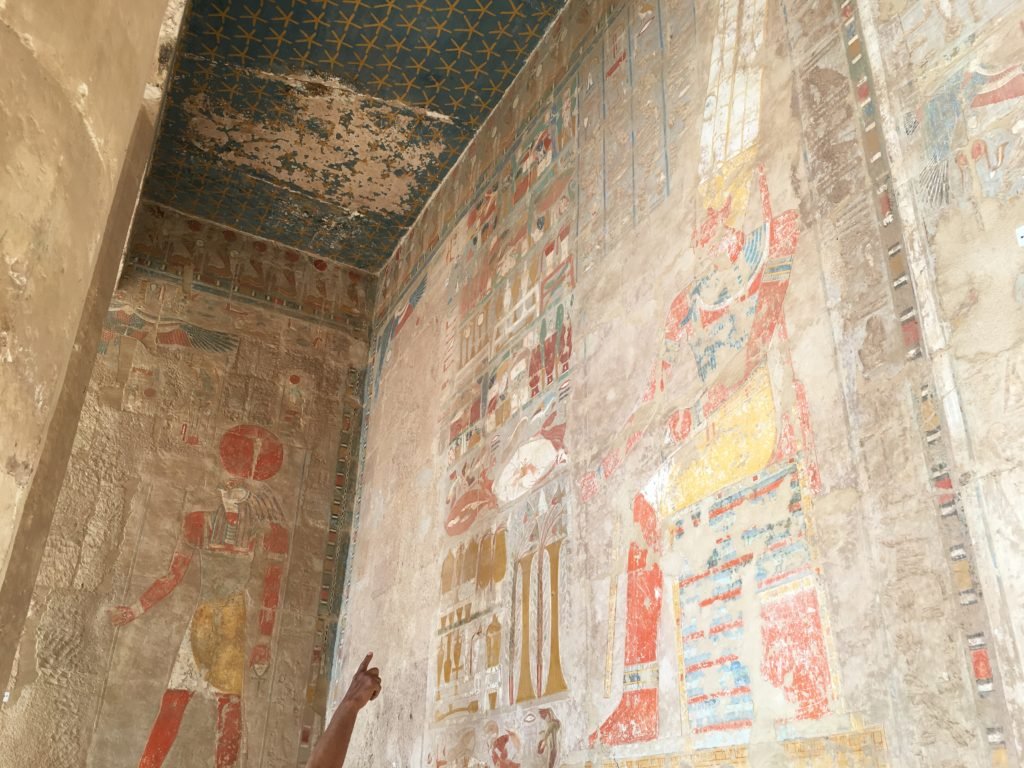
The whole concept of a female pharaoh was so unexpected, that Hatchepsut remained a mystery during centuries. Even her mummy was identified only recently, in 2007. Her identification relies on one of her teeth. Apparently, a DNA test linked an unknown female royal mummy which had a missing tooth with a tooth in a box wearing Hatchepsut’s name.
Her mummy is now at the Cairo museum. I saw her during my visit a few days ago, skinny, dry thing. Photos are strictly forbidden in the Museum mummies room, sorry. Trust me, it is not very pretty to look at. But what about 25 centuries earlier? Usually, royal representations are at the advantage of the royal person. Can you really believe that all these dynasties of pharaohs were beach surfing models? I don’t.
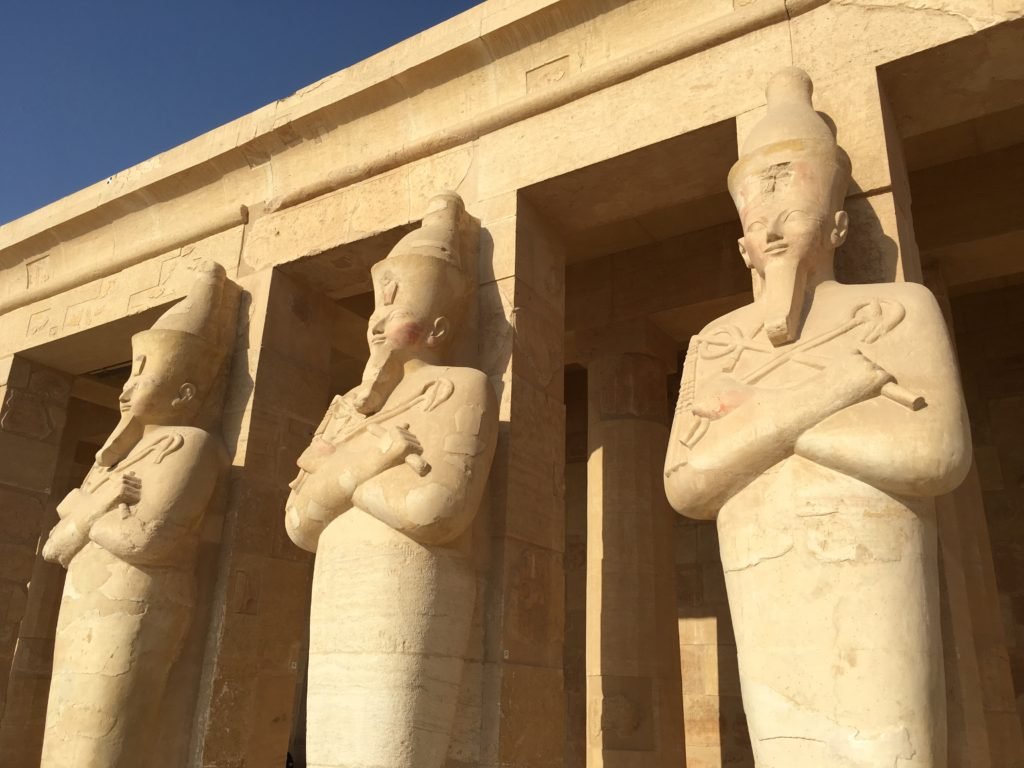
I wonder how Hatchepsut really looked like in her time. Looking at the statues and her mummy, it is hard to link the two of them together. The mummy description says that she was about 50 years old, overweighted and probably died of bone cancer. And she was missing at least one tooth.
Well, either the statues are based on the queen in her prime when she was young and thin. Or, this is a great marketing campaign, totally faking reality. It does not matter, Hatchepsut managed to leave her mark in History. I think she would like that.

Inside the tombs of Queens Valley
Hatchepsut was a queen before becoming a pharaoh. Yet, her mummy was found in the Valley of Kings (tomb KV60), not in Queens Valley. At the ticket office, I discover that only four tombs are open to the public today. One of them is the tomb of famous queen Nefertari, wife of Ramesses II, for which the visitor need to purchase a separate ticket.
Nefertari’s tomb remained closed for years and came under renovation. It is said it is the most beautiful of all. Ticket’s fee is 1.000 EGP which is about 60 USD, ouch! After inquiry with the ticket officer and debate with myself, I decide to skip it for today. After all, this is not the last time I come to Egypt. It is also nice to think I keep some exciting things for my next visit.
The first tomb I enter is the one of prince Kha-Em Wast, son of Ramesses III and discovered in 1903. Queens Valley actually contains tombs of queens but also princes who often died young. The tomb organization is similar to the ones in the Valley of Kings. It includes a corridor, small halls and burial chambers. But the scale here is much smaller. In a sense, the tombs are more intimate.
Young Kha-Em Wast wears the traditional side braid on his head and a leopard’s tunique. The last chamber is illuminated by the yellow background of the frescos. It echoes the first tomb I entered that day in the Valley of Kings, the tomb of Ramesses IV. Here the characters faces are all greenish. I learn that each colour has a symbolism. Blue for immortality and Amon, Green for life and Osiris, Yellow for women, Red for men.
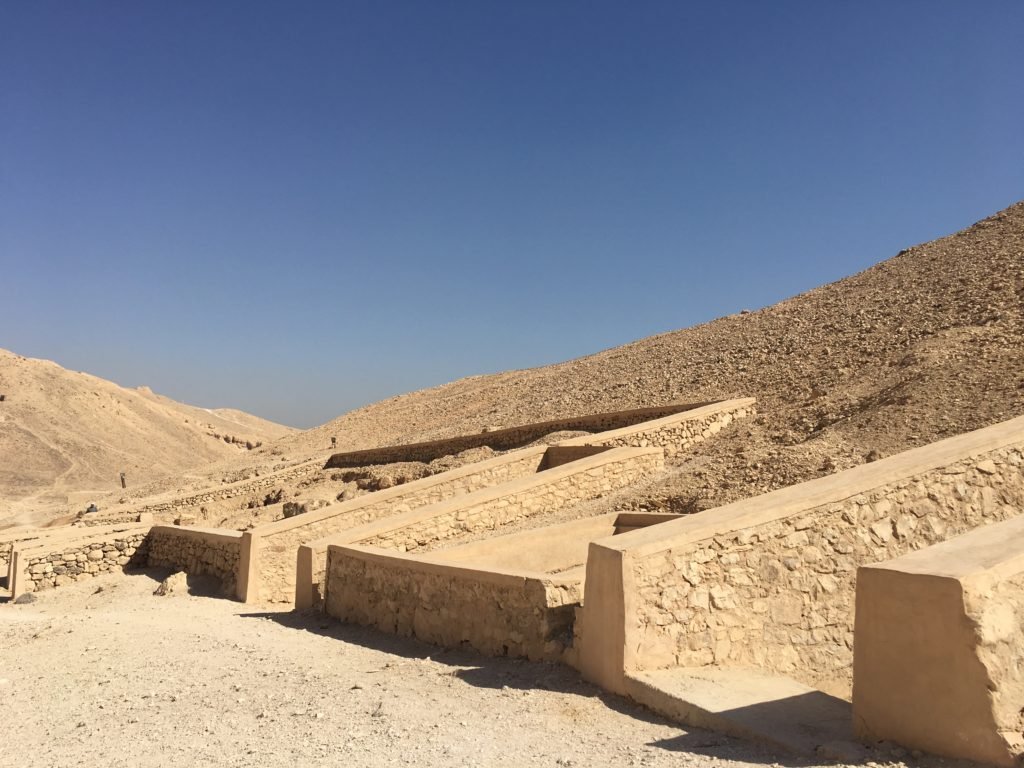
Next tomb belongs to Amon-Khopshef, another son of Ramesses III, discovered in 1904. Behind the glass protection, vivid scenes on the walls. The characters actually seem alive. You see the pharaoh greeting each god and introducing his son to them. The clothing and crowns are incredibly detailed and beautiful.
Here a khepresh, blue crown with a golden cobra. There, the traditional upper and lower Egypt white and red pschent. Further right, a blue and gold cap crown similar to the one ornamenting Tuthankamun’s death mask. On another scene, a tall golden hedjet and a red deshret. The walls are a fascinating antic fashion catwalk.
Queen Titi is the last tomb I visit and actuallly the only queen’s tomb I could see. The walls show queen Titi pregnant with her son by her side. Many exotic animals accompany them like baboons and lions. The familiar gods are here as well: Sobek, Horus, Anubis and Hathor. On the brown ceiling shine five pointed white stars.
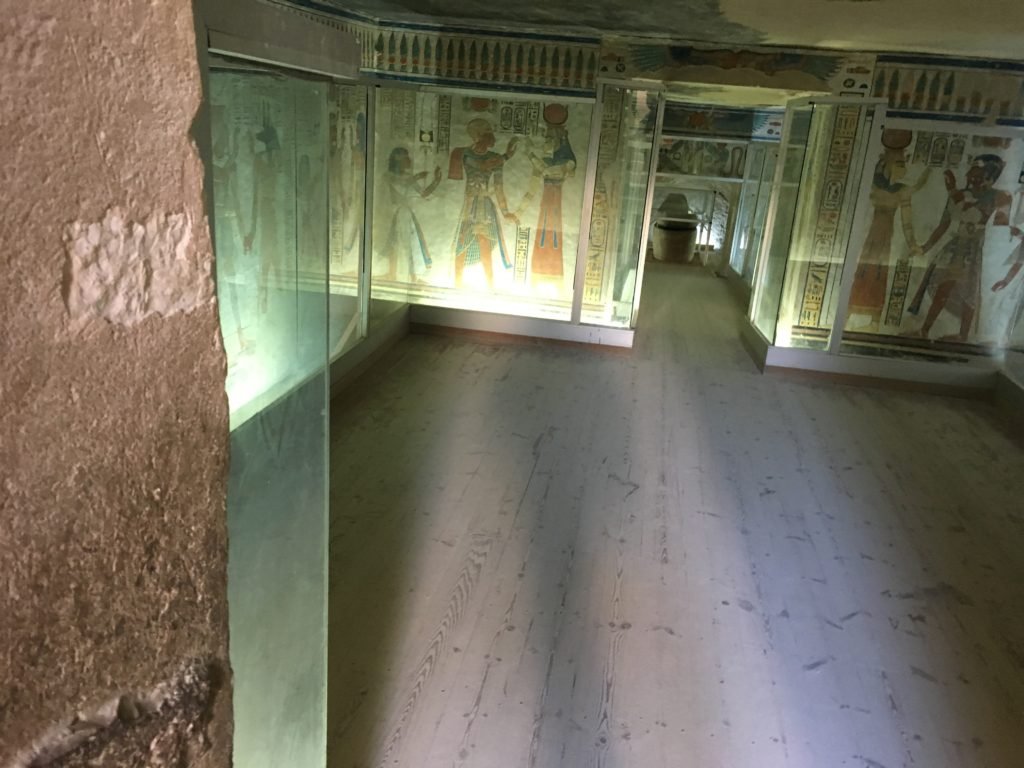
Tonight, when I will have dinner on the rooftop terrace of the hotel, I shall look towards the mountains on the West with a different eye. From outside, the uninitiated would see only a rocky landscape and the lights of Hatchepsut’s temple faraway. For an insider, I will recall the underground wonders of Queens Valley and the stunning view from Hatchepsut’s upper terrace.
I do not think much changed since her time. For sure, Luxor city is bigger and more modern than ancient Thebes. But put into perspective, Thebes was the heart of power in Egypt and that must have been quite something…
Just think of it for a minute. Valley of the Kings, Queens Valley, Valley of the Nobles, Hatchepsut and Medinet Habou temples on the West bank. And on the East, Luxor and Karnak temples, magnificent. If such wonders managed to make it until today, I can only imagine how splendid Thebes was at her zenith.


